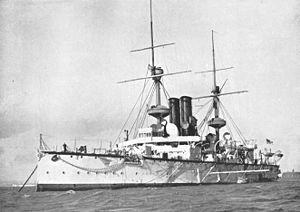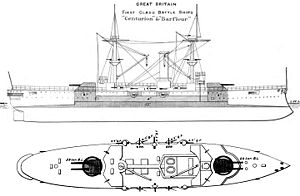- Centurion class battleship
-

HMS CenturionClass overview Name: Centurion Builders: Chatham Dockyard, Portsmouth Dockyard, Pembroke Dockyard Preceded by: Royal Sovereign class Succeeded by: Majestic class Built: 1890–1897 In commission: 1894–1913 Completed: 3 Retired: 3 General characteristics Type: Pre-dreadnought battleship Displacement: Centurion, Barfleur: 10,500 tons
Renown: 12,350 tonsLength: Centurion, Barfleur: 360 ft (110 m) (between perpendiculars)
Renown: 380 ft (120 m) (between perpendiculars); 408 ft (124 m) (overall)Beam: Centurion, Barfleur: 70 ft (21 m)
Renown: 72 ft (22 m)Draft: Centurion, Barfleur: 25 ft 6 in (7.77 m)
Renown: 26 ft 9 in (8.15 m)Speed: Centurion, Barfleur: 17 knots (31 km/h) (natural draft), 18.5 knots (34.3 km/h) (forced draft)
Renown: 17.5 knots (32.4 km/h) (natural draft), 18 knots (33 km/h) (forced draft)Endurance: 6,000 nmi (11,000 km) at 10 kn (19 km/h)[1] Complement: Centurion, Barfleur: 620
Renown: 674Armament: Centurion, Barfleur:
- 4 × BL 10-inch (254.0 mm) guns
- 10 × 4.7 inch (120 mm) QF guns
- 8 × 6-pounder guns
- 12 × 3-pounder QF guns
- 7 × 18 inch (450 mm) torpedo tubes (5 above water, 2 submerged)
Renown:
- 4 × BL 10-inch (254.0 mm) guns
- 10 × 6 inch (152 mm) QF guns
- 12 × 12-pounder QF guns
- 12 × 3-pounder QF guns
- 7 × 18 inch (450 mm) torpedo tubes (5 above water, 2 submerged)
Armor: Centurion, Barfleur:
- Belt: 9–12 inches (229–305 mm)
- Upper Belt: 4 inches (102 mm)
- Bulkheads: 8 inches (203 mm)
- Decks: 2–2.5 inches (51–63.5 mm)
- Conning Tower: 12 inches (305 mm)
- Barbettes: 5–9 inches (127–229 mm)
- Gunhouses: 6 inches (152 mm)
- Casemates: 6 inches (152 mm)
Renown:
Notes: Centurion and Barfleur later had their 4.7 inch (120 mm) guns replaced with 10 × 6 inch (152 mm) guns and had all five above-water torpedo tubes removed. The Centurion class battleships were second-class pre-dreadnought battleships of the Royal Navy designed for service on distant stations.
Contents
Description
The Centurion class comprised three ships, Centurion, Barfleur, and the slightly later Renown, the latter being built to a modified design. The ships were designed by Sir William White to be lightly armed battleships designed for service on the China Station and Pacific Station. Their relative lack of firepower enabled greater quantities of coal to be carried, extending their range, and it was not thought they would face the big guns of an enemy fleet. They were too lightly armed to slug it out with enemy battleships, but they could outrun them, and they were more than capable of dealing with armored cruisers that they were far more likely to meet on distant stations.[1]
They were considered good steamers and good seaboats, although the use of forced draft was discontinued because it damaged their boilers. Their draughts were designed to be shallow enough to allow passage through the Suez Canal and the navigation of rivers in China. Their hulls were sheathed with wood and copper to allow them to sail longer between docking.[1]
The ships were armed with four 10 inch (254 mm) guns in two barbettes covered by open-backed armored hoods and capable of all-around loading, a secondary armament of ten 4.7 inch (120 mm) guns, numerous smaller guns, and seven torpedo tubes. The previous Royal Sovereign-class battleships had allowed a comparison between high-freeboard ships with their main guns in open barbettes and low-freeboard ships equipped with old-style, heavy, circular turrets and had proven the superiority of the former in the rough waters of the Atlantic; the Centurions were the first barbette-type battleships with armored hoods over their barbettes, giving rise to the armored gunhouses that would be mounted on later ships and which themselves would come to be known as "turrets."
Centurion in 1901–1903 and Barfleur in 1902–1904 underwent a reconstruction in which their 4.7 inch (120 mm) guns were replaced by 6 inch (152 mm) guns in armored casemates, the additional weight being compensated for by reductions in their masts and the removal of all five of their above-water torpedo tubes. They were slightly slower, at about 16.75 knots (31.02 km/h), after these refits.[1]
Renown was an enlarged version of the earlier ships, with better armor, an improved armor layout, greater speed and endurance, and a heavier secondary armament. She also proved to be a good steamer and seaboat, with an easy roll.[2]
Like all pre-dreadnoughts, the Centurions were completely outclassed by the new dreadnought battleships that began to appear in 1906, and were scrapped a few years later after a period in reserve.
Ships in Class
HMS Centurion
HMS Centurion was launched in 1892 and completed in 1894. She served on the China Station as its flagship (1894–1901), served there again (1903–1905), then served in the Reserve Fleet (1905–1907) and Home Fleet (1907–1909) before being scrapped in 1910.[3]
HMS Barfleur
HMS Barfleur was launched in 1892 and completed in 1894. She served in the commissioned reserve (1894–1895), Mediterranean Fleet (1895–1898), China Station (1898–1901), Reserve Fleet (1904–1906), and Home Fleet (1907–1909) before being scrapped in 1910.[3]
HMS Renown
HMS Renown was launched in 1895 and completed in 1897. She served in various capacities in home waters in 1897, as flagship of the North America and West Indies Station (1897–1899), in the Mediterranean Fleet from 1899 to 1902, mostly as flagship, and again in 1903–1904). Upon her completion, she quickly became a favorite as a flagship because her design was especially congenial for entertaining visitors; by late 1902 she had begun to serve as an occasional royal yacht, and after some time in reserve was converted for that purpose in 1905. She became a stoker's training ship in 1909 and was decommissioned in 1913 and scrapped in 1914.[4]
Notes
References
- Burt, R. A. British Battleships 1889–1904. Annapolis, Maryland: Naval Institute Press, 1988. ISBN 0870210610.
- Chesneau, Roger, and Eugene M. Kolesnik, Eds. Conway's All The World's Fighting Ships 1860–1905. New York, New York: Mayflower Books Inc., 1979. ISBN 0831703024.
- Gibbons, Tony. The Complete Encyclopedia of Battleships and Battlecruisers: A Technical Directory of All the World's Capital Ships From 1860 to the Present Day. London: Salamander Books Ltd., 1983.
- Gray, Randal, Ed. Conway's All The World's Fighting Ships 1906–1921. Annapolis, Maryland: Naval Institute Press, 1985. ISBN 0870219073.
External links
- HMS Centurion
- The Dreadnought Project (Centurion and Barfleur)
- The Dreadnought Project (Renown)
Centurion-class battleshipPreceded by: Royal Sovereign class · Followed by: Majestic class
List of pre-Dreadnought battleships of the Royal NavyCategories:- Battleship classes
- Centurion class battleships
- Victorian era battleships of the United Kingdom
Wikimedia Foundation. 2010.

